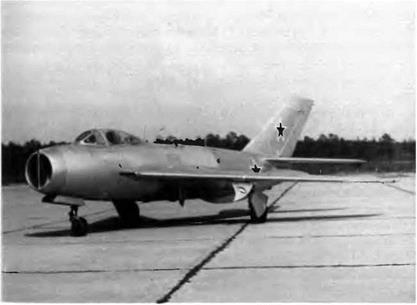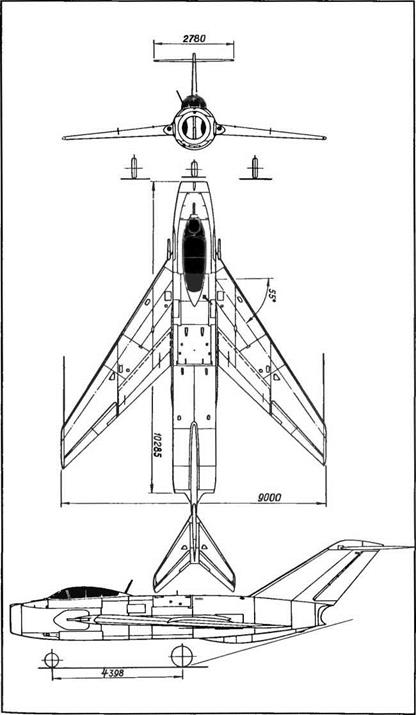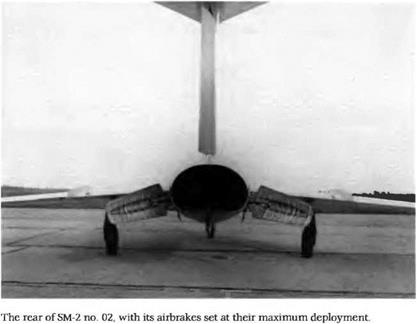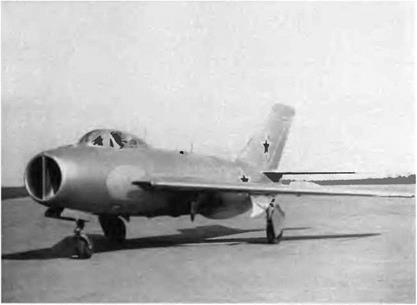1-360 / SM 2/SM 2A/SM 2B
To develop a fighter capable of supersonic speeds in level flight, many requirements had to be met:
—the layout had to have the smallest possible master cross-section to reduce drag
—the drag of the wing and the tail assembly had to be reduced by increasing their sweep angle at the leading edge —a series of intricate technical problems had to be resolved in designing duplicate flying controls, artificial feel systems, supersonic air intakes, and the like
—the engines and fuel systems had to be positioned to prevent flameouts during maneuvers within the aircraft’s speed and altitude range, including when firing the cannons
The SM-2 became the flying laboratory that allowed engineers to explore ways to get beyond the sound barrier.
The SM-2 was designed in record time under the supervision of A. G. Brunov, deputy chief constructor, and R. A. Belyakov, who was then
|
|
|

|
The SM-2 no. 02, built at the same time as no. 01 also had a stabilizer set high on the fin |
chief of the general affairs brigade. A. A. Chumachenko took care of the aerodynamic design while V. M. Yezuitov studied pilotage and handling problems. Engineer A V Minayev played a great part in the development of the SM-2. G. Ye. Lozino-Lozinskiy was put in charge of the power unit. The stress analysis was placed under the management of D. N. Kurguzov, who had worked with N N. Polikarpov before World War II.
The first SM-2 was a midwing, T-tail, twin-jet fighter. The wing sweep back C/4 was 55 degrees with a 4-degree, 30-minute anhedral. The sweep of the stabilizer and fin leading edges was 55 and 56 degrees, respectively. The wing structure was identical to that of the I – 350 (M) except that there were only two fences on the wing’s upper surface. Armament consisted of two N-37D cannons located in the leading edge, near the wing roots. Rolled out in April 1952, the SM-2 made its first flight, with G. A. Sedov in the cockpit, on 24 May.
It soon became obvious that the aircraft could not really exceed Mach 1 in level flight. It did reach Mach 1.19—but in a shallow dive. At 3,920 daN (4,000 kg st) the cumulative thrust of the two first-series AM – 5A turbojets was not sufficient because they lacked an afterburner. The engines were replaced by reheated AM-5Fs—first developed for the SM-1—rated at 2,645 daN (2,700 kg st). Other faults were noted in the aircraft’s aerodynamic qualities and fuel control system.
|
1-360 (SM-2) (MiG ОКБ three-view drawing) |
|
|
The spin problem was solved by moving the stabilizer to the base of the fin and modifying the location of the wing fences. Various other changes put a stop to engine flameouts and surges. After completing its factory tests, the SM-2 commenced its state trials in early 1953 They proceeded normally until V. G. Ivanov, a military pilot, discovered a serious shortcoming: a pitch instability caused by diminution of the stabilizer’s efficiency at high speeds. The flight tests were canceled, and the prototype was returned to the factory for modifications. The stabilizer was lowered once more and positioned on the rear section of the fuselage. The tailplanes on MiG fighters have remained on the fuselage and "abandoned” the fin ever since. Moreover, to suppress the buffeting caused by their deployment, the airbrakes were brought closer to the wing and lowered in relation to the fuselage datum line.
Once modified, the SM-2 became the SM-2A and later the SM-2B. The aircraft resumed its state trials in the summer of 1953. In fact, two SM-2s were built. In light of the test results both prototypes received the same modifications, especially those involving the stabilizer.
Specifications
Span, 9.04 m (29 ft 7.9 in); overall length, 13.9 m (45 ft 7.2 in); fuselage length, 10.285 m (33 ft 8.9 in); height, 3.95 m (12 ft 11.5 in); wheel
|
|
|

|
Reengined with two AM-9Bs, the SM-2B became the SM-9/1—true prototype of the MiG-19 |
track, 4.156 m (13 ft 7.6 in); wheel base, 4.398 m (14 ft 5.2 in), takeoff weight, 6,820 kg (15,030 lb).
Design Performance Mach limit, 1.19
















